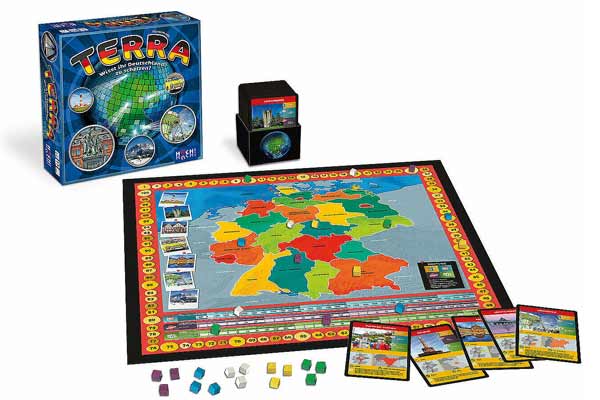With the animals Friedemann Friese launched a cognitive game at HUCH in 2008 that was about animals. The game, which was very successful at the time, became on the list of nominees for the Game of the Year award in 2009. In 2014 there was a successor, so to speak Tera, also by Friedman Friese. Visual similarities, from the box to the game plan, clearly refer to the ancestor, but now it’s not primarily about animals, but about numbers, data, the geographical location of buildings, natural phenomena and historical events. After that there is another problem Terra Munich and copy Tera on tour There, the series continued into 2020 with a focus on Germany. The vague subtitle “Do you know how to appreciate Germany” suggests that here, too, it’s not necessarily just about factual, accurate knowledge.
How does Terra Germany work?
In addition to the 100 Terra cards printed on both sides, there is a game plan with a map of Germany and a perimeter scoring tape. There are also three scales for the year, length/distance and number. There are guessing stones for each player. There is a Terra card chest from which only the top half of the cards protrude. This top half displays the information players receive in order to place their pieces accordingly.
Each player has five guessing stones available. At the beginning of the game, the number of cards to be played together is determined.
The player receives the card chest and reads the subject and tasks on the first card (Caution: the card must not be drawn from the chest). Starting with the starting player, players alternately place their guessing stones on an empty area on the board or on an empty space on one of the three scales. Each player decides for himself how many guesses he wants to use. You can also place several stones on empty spaces on the game board or on the same scale. If you don’t want to use the stone anymore, you pass.
The evaluation is done at the end of the round. To do this, the card is taken out of the box. Correctly placed guessing stones result in seven points. If a stone is placed right next to the correct solution, it still scores three points. If the player is the only one betting on the scale, the points scored on this scale are doubled. Placed stones and yield points are returned to the owner’s inventory. Listed stones that do not yield any points are collected next to the game board. At the end of the round, each player retrieves one of their guessing stones from the warehouse next to the game board. If the player has less than three guessing stones, he can replenish his own supply to three guesses. The player with the most points after the last rounds agreed at the beginning of the game wins the game.
Is Terra Germany worth it?
all of that Tera Know and want a new theme alternative with Terra Germany. But whether the game is so well known that the author’s name is not mentioned on the lid of the box, since everyone knows who the game is, I dare to doubt. The fact that the author can only be found in the small print on the back of the rules of the game and in the small print on the back of the box is definitely antiquated.
The Appreciation Mechanism has always been well received on our tours. The fact that there are still points to be earned for “just a tick” is always well received. The questions are a colorful mix of different topics and sometimes they are so particular that there is hardly anyone who can answer all the questions exactly. The 100 cards are printed on both sides, thus it can provide puzzle fun for a long time. TeraFans should definitely grab this one.

“Explorer. Communicator. Music geek. Web buff. Social media nerd. Food fanatic.”







More Stories
A fossilized creature may explain a puzzling drawing on a rock wall.
MrBeast Sued Over ‘Unsafe Environment’ on Upcoming Amazon Reality Show | US TV
Watch comets Lemmon and SWAN approach Earth today